
D. Li et al. / Journal of Biosciences and Medicines 1 (2013) 22-25
Copyright © 2013 SciRes. OPEN ACCESS
Table 1. The FMD clinical incidence after challenge.
Groups Pig No & clinical incidence
206 (1/1) 3051 (−) 3056 (−) 3057 (−) 3076 (−) 3098 (−)
206 (1/3) 4441 (−) 3074 (−) 3047 (−) 3075 (−) 3077 (−)
206 (1/9) 3072 (−) 3060 (+) 3063 (−) 3065 (+) 3083 (−)
201 (1/1) 3058 (−) 3059 (−) 4477 (−) 3079 (−) 3086 (−)
201 (1/3) 3097 (−) 3073 (−) 3094 (−) 3082 (−) 3043 (−)
201 (1/9) 3064 (−) 3092 (−) 3081 (−) 3070 (−) 3069 (−)
PBS (1/1) 3055 (−) 3067 (−) 3093 (+) 3084 (+) 3089 (+)
PBS (1/3) 3054 (−) 3061 (+) 3095 (+) 3068 (−) 3088 (+)
PBS (1/9) 3044 (+) 3090 (+) 3087 (+) 3085 (+) 3096 (+)
Control 3099 (+) 1040 (+) 1439 (+) 3080 (+) 3071 (+)
Note: (+) means FMD clinic sighs appeared.
4. DISCUSS
The ISA206 adjuvant has applied in FMD vaccine pro-
duction and other vaccines for 20 years, because it has
lower side-reactions and viscosity, easier to emulsify and
injection, and higher stability. Recen tly, T he ISA 201 has
developed on the base of ISA 206, which inherited ad-
vantages of ISA 206, and added some chemical sub-
stances with the hope of enhanci ng animals’ cellular im-
mune reactions [16]. In this report, the comparisons be-
tween ISA 201 and ISA 206 were done as the FMD vac-
cine respectively.
First the ELISA antibodies against FMDV type O
were compared. The antibody titer induced by 201-vac-
cine were higher than which of 206-vaccine on 3dpv,
7dpv, 14dp v, 21 dpv , 2 8dpv. This means that the effect of
201-vaccine in inducing antibody is better than which of
206-vaccine.
The virus challenge trial to vaccinated animals is a
very important index for evaluating the potency of FMD
vaccine, which is indicated with PD50 (50 percent pro-
tection dose) [17,18]. Here, fifty pigs were all protected
immunized with 201 vaccine, but thirty pigs were pro-
tected with 206 vaccine, which means that the potency of
201 vacci ne is better than that of 206 va c c i ne.
5. CONCLUSION
From above, the efficacy of the FMD vaccine emulsified
with ISA 201 is su pe rior to ISA 206.
6. ACKNOWLEDGEMENTS
This work has been supported by “Seppic, France”.
REFERENCES
[1] Reuckert, R.R. (1996) Picornaviridae: the viruses and
their replication. In: Fields, B.N., Knipe, D.M. and How-
ley, P.M. Eds., Fields Virology, Lippincott-Raven, Phila-
delphia, 609-654.
[2] Doel, T.R. (2003) FMD vaccines. Virus Research, 91, 81-
99. http://dx.doi.org/10.1016/S0168-1702(02)00261-7
[3] Ward, M.P., Laffan, S.W. and Highfield, L.D. (2007) The
potential role of wild and feral animals as reservoirs of
foot-and-mouth disease. Preventive Veterinary Medicine,
80, 9-23.
http://dx.doi.org/10.1016/S0168-1702(02)00261-7
[4] Doel, T.R., Williams, L. and Barnet, P. (1994) Emergen-
cy vaccination against foot-and-mouth disease: Rate of
development of immunity and its implications for the car-
rier state. Vaccine, 12, 592-600.
http://dx.doi.org/10.1016/0264-410X(94)90262-3
[5] Barnett, P.V., Pullen, L., Williams, L. and Doel T.R.
(1996) International bank for foot-and-mouth disease:
Assessment of Montanide ISA 25 and ISA 206, two
commercially available oil adjuvants. Vaccine, 14, 1187-
1198. http://dx.doi.org/10.1016/S0264-410X(96)00055-2
[6] Hunter, P. (1996) The performance of southern African
territories serotypes of foot and mouth disease antigen in
oil-adjuvanted vaccines. Revue Scientifique et Technique,
15, 913-922.
[7] Cox, S.J., Barnett, P.V., Dani, P. and Salt J.S. (1999)
Emergency vaccination of sheep against foot-and-mouth
disease: Protection against disease and reduction in con-
tact transmission. Vaccine, 17, 1858-1868.
http://dx.doi.org/10.1016/S0264-410X(98)00486-1
[8] Doel, T.R. and Pullen, L. (1990) International bank for
foot-and-mouth disease vaccine: stability studies with vi-
rus concentrates and vaccines prepared from them. Vac-
cine, 8, 473-478.
http://dx.doi.org/10.1016/0264-410X(90)90249-L
[9] Barnett, P.V. and Carabin, H. (2002) A review of emer-
gency foot-and-mouth disease (FMD) vaccines. Vaccine,
20, 1505-1514.
http://dx.doi.org/10.1016/S0264-410X(01)00503-5
[10] Sonia, A.M. (2007) Studies on preparation improved
FMD virus oil adjuvant vaccine. VMVSc Thesis (Virol-
ogy), University of Cairo, Cairo.